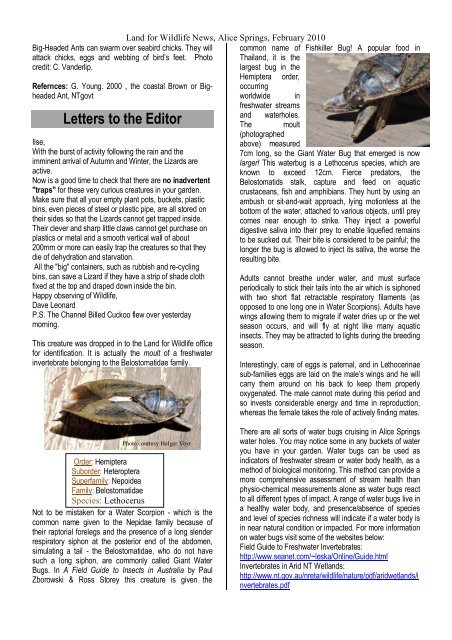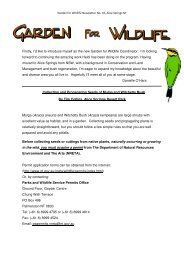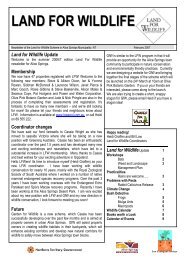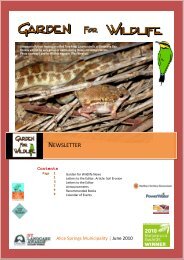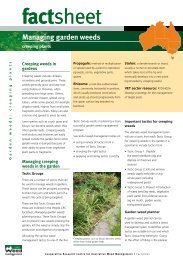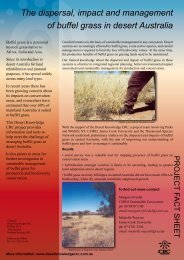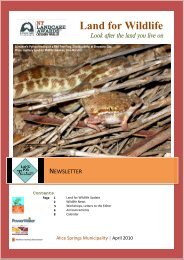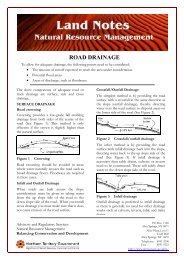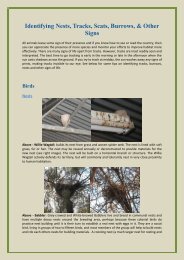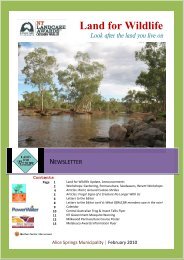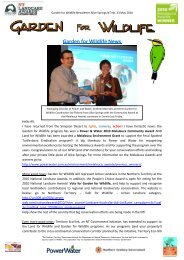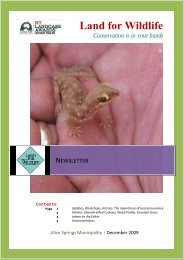Pest Profile - Low Ecological Services
Pest Profile - Low Ecological Services
Pest Profile - Low Ecological Services
Create successful ePaper yourself
Turn your PDF publications into a flip-book with our unique Google optimized e-Paper software.
Big-Headed Ants can swarm over seabird chicks. They will<br />
attack chicks, eggs and webbing of bird‟s feet. Photo<br />
credit: C. Vanderlip.<br />
Refernces: G. Young. 2000 , the coastal Brown or Bigheaded<br />
Ant, NTgovt<br />
Letters to the Editor<br />
Ilse,<br />
With the burst of activity following the rain and the<br />
imminent arrival of Autumn and Winter, the Lizards are<br />
active.<br />
Now is a good time to check that there are no inadvertent<br />
"traps" for these very curious creatures in your garden.<br />
Make sure that all your empty plant pots, buckets, plastic<br />
bins, even pieces of steel or plastic pipe, are all stored on<br />
their sides so that the Lizards cannot get trapped inside.<br />
Their clever and sharp little claws cannot get purchase on<br />
plastics or metal and a smooth vertical wall of about<br />
200mm or more can easily trap the creatures so that they<br />
die of dehydration and starvation.<br />
All the "big" containers, such as rubbish and re-cycling<br />
bins, can save a Lizard if they have a strip of shade cloth<br />
fixed at the top and draped down inside the bin.<br />
Happy observing of Wildlife,<br />
Dave Leonard<br />
P.S. The Channel Billed Cuckoo flew over yesterday<br />
morning.<br />
This creature was dropped in to the Land for Wildlife office<br />
for identification. It is actually the moult of a freshwater<br />
invertebrate belonging to the Belostomatidae family.<br />
Order: Hemiptera<br />
Suborder: Heteroptera<br />
Superfamily: Nepoidea<br />
Family: Belostomatidae<br />
Species: Lethocerus<br />
Not to be mistaken spp.<br />
for a Water Scorpion - which is the<br />
common name given to the Nepidae family because of<br />
their raptorial forelegs and the presence of a long slender<br />
respiratory siphon at the posterior end of the abdomen,<br />
simulating a tail - the Belostomatidae, who do not have<br />
such a long siphon, are commonly called Giant Water<br />
Bugs. In A Field Guide to Insects in Australia by Paul<br />
Zborowski & Ross Storey this creature is given the<br />
Land for Wildlife News, Alice Springs, February 2010<br />
Photo courtesy Holger Voyt<br />
common name of Fishkiller Bug! A popular food in<br />
Thailand, it is the<br />
largest bug in the<br />
Hemiptera order,<br />
occurring<br />
worldwide in<br />
freshwater streams<br />
and waterholes.<br />
The moult<br />
(photographed<br />
above) measured<br />
7cm long, so the Giant Water Bug that emerged is now<br />
larger! This waterbug is a Lethocerus species, which are<br />
known to exceed 12cm. Fierce predators, the<br />
Belostomatids stalk, capture and feed on aquatic<br />
crustaceans, fish and amphibians. They hunt by using an<br />
ambush or sit-and-wait approach, lying motionless at the<br />
bottom of the water, attached to various objects, until prey<br />
comes near enough to strike. They inject a powerful<br />
digestive saliva into their prey to enable liquefied remains<br />
to be sucked out. Their bite is considered to be painful; the<br />
longer the bug is allowed to inject its saliva, the worse the<br />
resulting bite.<br />
Adults cannot breathe under water, and must surface<br />
periodically to stick their tails into the air which is siphoned<br />
with two short flat retractable respiratory filaments (as<br />
opposed to one long one in Water Scorpions). Adults have<br />
wings allowing them to migrate if water dries up or the wet<br />
season occurs, and will fly at night like many aquatic<br />
insects. They may be attracted to lights during the breeding<br />
season.<br />
Interestingly, care of eggs is paternal, and in Lethocerinae<br />
sub-families eggs are laid on the male‟s wings and he will<br />
carry them around on his back to keep them properly<br />
oxygenated. The male cannot mate during this period and<br />
so invests considerable energy and time in reproduction,<br />
whereas the female takes the role of actively finding mates.<br />
There are all sorts of water bugs cruising in Alice Springs<br />
water holes. You may notice some in any buckets of water<br />
you have in your garden. Water bugs can be used as<br />
indicators of freshwater stream or water body health, as a<br />
method of biological monitoring. This method can provide a<br />
more comprehensive assessment of stream health than<br />
physio-chemical measurements alone as water bugs react<br />
to all different types of impact. A range of water bugs live in<br />
a healthy water body, and presence/absence of species<br />
and level of species richness will indicate if a water body is<br />
in near natural condition or impacted. For more information<br />
on water bugs visit some of the websites below:<br />
Field Guide to Freshwater Invertebrates:<br />
http://www.seanet.com/~leska/Online/Guide.html<br />
Invertebrates in Arid NT Wetlands:<br />
http://www.nt.gov.au/nreta/wildlife/nature/pdf/aridwetlands/i<br />
nvertebrates.pdf


